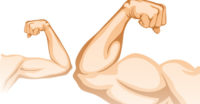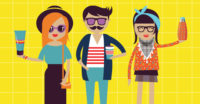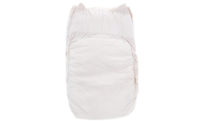Brand Packaging: Packaging Design
Redesigning the Packaging Playbook
Making your brand stand out on a shelf full of copycats.






Marketers have done a pretty good job training consumers to recognize visual signals on packaging. Green indicates freshness, white cues purity, hand-rendered typography means a product is “artisan” and so on. But what happens when most consumer packaged goods companies play by the same rules in the packaging playbook? It’s a recipe for uniformity.
Yes, brand owners need to understand the science of packaging design; yes, it’s wise to respect the visual norms across your brand’s category so you don’t throw the consumer for a loop. But packaging is as much an art as a science, and the art lies in the balance between what’s expected and what’s distinctive.
The Science of Packaging Design: 30-10-3
A brand’s packaging is often your first or only contact with the consumer, so it has to work hard: to attract, to inform, to entice, to persuade. In the retail environment (and you can draw logical parallels to the online shopping experience), a consumer product package has three singular moments in which to engage a consumer:
- At 30 feet, it needs to define the category.
- At 10 feet, it needs to make the brand name and story known.
- At 3 feet, it has the opportunity to whisper in the consumer’s ear.
From 30 Feet
This is the initial opportunity for your package to attract attention and stop consumers in their tracks. As the shopper approaches the aisle or lands on the category when she’s browsing online, the package has to make an immediate impact. Here’s how to halt traffic at 30 feet:
Logo or Wordmark: A simple, reads-at-a-glance logo defines your brand in the consumer’s mind as a trusted leader in the category.
Photography: In seconds, a great photo communicates all kinds of information about the product: freshness, taste appeal, health benefits, quality. For a great example, look at Sahale Snacks packaging, which features super-close-up beauty shots of the ingredients in all of their mouthwatering glory. It’s visible from across the store, and it acts as a tractor beam luring shoppers who can’t help but think, “That product must taste amazing.”
Distinctive Attributes: Another effective way to capture attention from 30 feet is to trumpet your product’s features and benefits. This is especially true if you are the first to market on an innovative product or flavor, or if you have a distinctive spin on the category. Consider Dang Foods, which fits comfortably into the snacking category but positions its products as an Asian-American take on snacks.
From 10 Feet
Now that the consumer has spotted your package from across the aisle or in online search results, you need to keep her attention and take another step toward the sale:
Declare Your Differences: She’s closer, so your packaging has a bit more time to speak to her. Tell her why she should believe in your brand and choose your product over another, but don’t overwhelm her with messaging.
Emphasize Readability: Create a logical reading hierarchy for your consumer using size and scale of typography. If your logo shouts from 30 feet and then at 10 feet, you will want to talk about product, flavor, taste and benefit. Clarity of communication engenders trust.
From 3 Feet
Now that the consumer is holding your package, how do you entice her to purchase?
Invite Her In: Since she’s picked up your package, she’s given you permission to connect on a deeper level. Now is the time to educate her about your brand story, engage her with your distinctive voice, explain the benefits of your product. Help her understand how the brand syncs with her life and values.
Get Her to Flip It: Unless she’s already a fan of your offering, she’ll read the back of the pack before she buys. And here’s where your brand’s message and voice truly come to life. She’ll also look at the nutrition facts and ingredient labels and decide if you’re walking the walk.
The Art of Balancing Same & Different
The science of creating a package that reads from a distance and prompts that moment of pick-up on the shelf has proven valid in the real world and online. Artistry stems from crafting the right balance between similar and standout. It’s important to match the contemporary visual lexicon of your product category — and at the same time to step to the forefront of that. That’s how brands become disruptive at shelf. Here are four strategies:
Design Beyond Category Norms
Again, let’s look at Sahale Snacks. Within the snack nuts subcategory, there’s a set of standard conventions that unites the shelf: single serving pouch, photo of the nut on the front, bright primary colors to indicate fun. With a packaging redesign, Sahale checked those boxes — and then completely disrupted the category, with culinary flavors, jewel-tone packaging that changes by flavor, a photo strategy that zooms in on the naturalness and deliciousness of the product, and a “Snack Better” messaging that cues a healthier profile than competitors. Now, every other brand in the space is playing catch-up.
While most bottled water brands wrap themselves in shades of blue, Essentia zagged hard, with a black and red palette that defies the category. This enhanced-water product stands out as premium, approachable, youthful, and badge-worthy.
Promote Health & Wellness
Better-for-you (BFY) versions of products are driving growth across CPG categories. Therefore, a successful package design has to lean heavily on visual and verbal messaging that promotes healthy features and benefits. On a shelf crowded with BFY (and not so much) products, copy can reinforce that wellness spin. For example, Lesser Evil promotes a healthier version of snacks with clean ingredients that help consumers feel like they will not be shortchanging themselves by eating something less evil (for them and the planet) than, say, kettle-cooked potato chips. It starts with a killer name, but the brand also succeeds because it combines a BFY ingredient profile with an engaging voice that doesn’t take itself too seriously. So many healthy brands get caught up in their own virtuosity, making the product seem like a compromise rather than a treat.
Leverage Whitespace
Envision how your suite of products would look shelved together, and design a system that creates a singular unit. A consistent background is one way to do that — think: whitespace, but it doesn’t have to be white. In the nutritional supplements category, the new Anser! Brand swaps the common medicinal-white background with solid black. Metallic colors for the brand name splash across the black, adding a sense of fashion, inclusion and uniqueness that represents the brand’s founder, actress and influencer Tia Mowry. The packaging really shines online, where it stands out against the white backdrop that’s standard for most ecommerce platforms.
REBBL is another brand that uses whitespace to bold effect in the kombucha/tonic/health beverage space. Rather than a clear bottle, the brand opted for an opaque wrap with a solid background keyed to the product (a warm, light brown for its chocolate reishi drink, for example). The brand is super-virtuous even for the BFY market, with ethical sourcing and an anti-human-trafficking mission — and the distinctiveness of the packaging reinforces REBBL’s position.
Your brand has its own story, strategy and unique selling proposition. And your design choices in packaging depend on what’s most important to your consumer. The science of packaging design will help her discover your brand; the art will prompt her to fall in love.
Looking for a reprint of this article?
From high-res PDFs to custom plaques, order your copy today!









